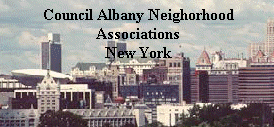ALBANY -- It was 1968, and Gov. Nelson
A. Rockefeller wanted to build a north-south highway arterial connecting
Empire State Plaza with the interstate.
The Mid-Crosstown Arterial, as it was called, would have sliced through
the Center Square neighborhood, tunneled under Washington Park and come
out near Interstate 90.
This year's Hidden City House & Garden Tour, the 18th annual
edition, will celebrate the fact Rockefeller didn't get his way 40 years
ago.
At least three of the Jay Street row houses included on Thursday's tour
would have been demolished. Other properties may have been torn down, too,
and the entire historic neighborhood, as well as the park, would have been
fundamentally altered.
"We're celebrating the activism of the neighbors 40 years ago, who
stopped the arterial," said Dixie Hathaway, chairwoman of the tour.
It is the sole fundraiser of the Center Square and Hudson/Park
neighborhood associations and also supports preservation activities of the
Historic Albany Foundation.
"There's still a lot of pride here, and we're hoping for good
weather and a strong turnout for this year's tour, as we showcase these
wonderful neighborhoods," she said.
Although some residents moved out of those blocks in the late-'60s in
anticipation of losing their properties to eminent domain after the
arterial was proposed, others fought back with petitions and a spirited
public campaign to halt the massive transportation project.
"It would have divided the neighborhood in a very adverse fashion
and ruined the park," said Ellie Posner, 86, a founder of the Center
Square Association in 1957. She lived on Willett Street across from the
park for many years before moving to an assisted-living community.
"We were very worried about the arterial and we banded together to
stop it," Posner recalled. "We generated a lot of interest,
because people were concerned about what it would have done to their
properties."
In addition to widespread vocal opposition, an estimated cost of more
than $150 million in 1968 for the 2.75-mile "cut-and-fill"
segment of the arterial also led to its demise.
Although it was eventually scrapped, state transportation officials had
drawn up renderings and preliminary plans for the arterial.
Mark and Renee Benson are pleased master builder Rockefeller wasn't
able to push through the arterial since their 1868 row house at 190 Jay
St. was slated to be torn down. They'll show off their restoration of the
house and garden on the tour.
"We love our house and this neighborhood. The arterial would have
destroyed a great part of the city," said Mark Benson, who works from
a home office as an IBM manager. His wife, Renee, is executive director of
Catholic Charities Caregivers Support Services in Albany. The parents of
three grown sons moved to Albany from Saugerties three years ago.
Their house was one of 14 houses built just off Lark Street on Jay
Street in 1867-68 and leased to workers at the Amsdell Brewery across the
street (now the Knickerbocker Apartments).
The Bensons' extensive restorations to the tri-level brick structure
included a gourmet kitchen with mahogany countertops, hickory cabinets and
radiant heat. They also landscaped the backyard garden with pavers,
perennials and shade trees.
"It's so sheltered and quiet in the backyard that you don't
realize you're in the heart of the city," Benson said.
At 344 Hudson St., the second stop on the tour, Douglas Cohn, a
veterinarian, will invite guests to sip tea, listen to cellist Garfield
Moore and enjoy the soothing sound of rushing water from his
Japanese-inspired backyard koi pond and lush shade garden.
"It's hard to describe what this garden does for me aesthetically
after a long day at work. The sound of the waterfall, the beautiful
flowers. It's very relaxing," said Cohn, who moved 10 years ago from
Nyack, Rockland County, into the 1885 Queen Anne home built by the Pruyn
family, which was in the lumber industry.
He hired a landscape architect and pond builder to create his vision
for a backyard oasis with Asian influences.
"This backyard and the others around here weren't much to look at
10 years ago," he said. "But when everyone saw how beautiful a
backyard in the city could be, a lot of people started really working on
their backyards and it's been a great development," Cohn said.
Paul Grondahl can be reached at 454-5623 or by e-mail at pgrondahl@timesunion.com.
Find out what's inside Albany's Hidden City
What: 18th annual Hidden City House & Garden Tour in Albany's
historic neighborhoods
When: 5-8 p.m. Thursday, June 19
Tickets: $20 per person; available at Ben & Jerry's, 250 Lark St.,
and Historic Albany Foundation, 472 Madison Ave. You can download a
prepaid ticket order form or view photos at http://www.hidden-city.org
Benefits: the Center Square Neighborhood Association, Hudson/Park
Neighborhood Association and Historic Albany Foundation.
HOUSES AND GARDENS ON THE TOUR
1. 266 Lark St.: 1885 Queen Anne town house
2. 344 Hudson Ave: Japanese-inspired garden and koi pond
3. 306 Hudson Ave.: Amrose Sable Gallery
4. 300 Hudson Ave.: 1848 Greek revival
5. 190 Jay St.: Recently restored 1868 row house
6. 170 Jay St.: 1875 Italianate town house
7. 150 Jay St.: 1873 home recently reconverted into single-family
8. 133 Jay St.: 1874 Italianate town house
9. Wilborn Temple: corner of Lancaster and South Swan streets
10. 299 Lark St.: Elissa Halloran Designs
11. 336 State St.: 1831 wood-frame house
12. 312 State St.: 1870s Queen Anne brownstone
- Paul Grondahl
